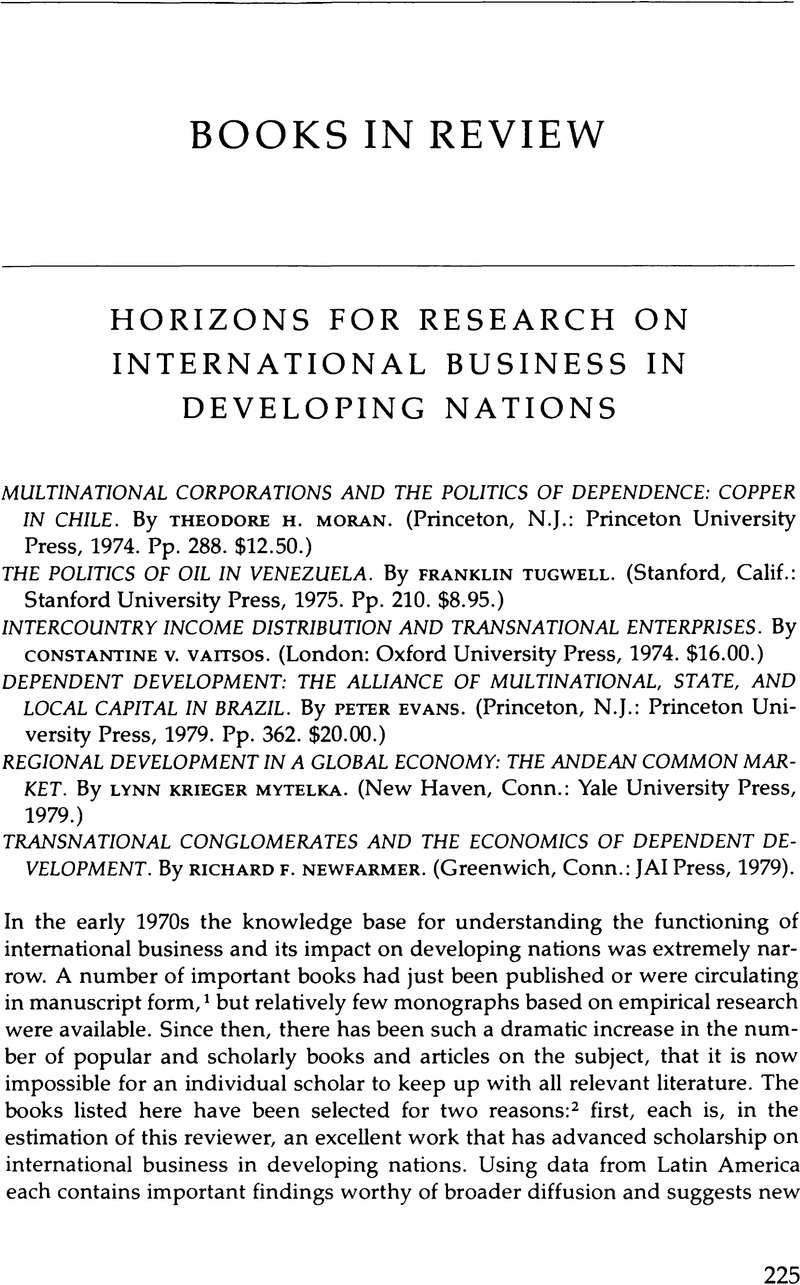No CrossRef data available.
Article contents
Horizons for Research on International Business in Developing Nations
Review products
Published online by Cambridge University Press: 24 October 2022
Abstract

- Type
- Books in Review
- Information
- Copyright
- Copyright © 1980 by Latin American Research Review
References
Notes
1. For example, Yair Aharoni's The Foreign Investment Process was published in 1966 (Boston, Mass.: Harvard Business School), Edith Penrose's The Large International Firm in Developing Countries in 1969 (London: Allen & Unwin), Mira Wilkins' The Emergence of Multinational Enterprise in 1970 (Cambridge, Mass.: Harvard University Press), Raymond Vernon's Sovereignty at Bay in 1971 (New York: Basic Books), and Stephen Hymer's The International Operations of National Firms circulated as a Ph.D. dissertation from 1960 until it was published in 1976 by the M.I.T. Press.
2. Although these six monographs provide an excellent start, many other fine books have been written on international business in developing nations, using data from Latin America, since 1970. Some are listed in the notes to this essay.
3. Transfer pricing is the setting of prices of goods and services exchanged by affiliates of a single corporation. In the case of TNCs, if such exchanges are unregulated, the manipulation of transfer prices allows the firm to declare profits in locales that minimize its tax liability or achieve some other corporate objective, rather than relating prices to value added in a given locale.
4. Reported in C. Fred Bergsten, Thomas Horst, and Theodore H. Moran, American Multinationals and American Interests (Washington, D.C.: The Brookings Institution, 1978), p. 379.
5. See Raymond Vernon, Storm over the Multinationals: The Real Issues (Cambridge, Mass.: Harvard University Press, 1977), pp. 154–58.
6. For a synthesis of current research on this topic, see David Collier (ed.), The New Authoritarianism in Latin America (Princeton, N.J.: Princeton University Press, 1979). A recently published study concerned with these issues, which includes a chapter on the state and international business, is Alfred Stepan, The State and Society: Peru in Contemporary Perspective (Princeton, N.J.: Princeton University Press, 1978).
7. For a discussion of the operations of TNCs in a small developing nation, see Charles T. Goodsell, American Corporations and Peruvian Politics (Cambridge, Mass.: Harvard University Press, 1974). This book differs from those under review here by examining political impacts and paying less attention to the consequences of international business for economic development.
8. See, for example, Mira Wilkens, The Maturing of Multinational Enterprise (Cambridge, Mass.: Harvard University Press, 1973), pp. 65–72 and 294–95; and two reports prepared by the Federal Trade Commission, Report on the Supply of Electrical Equipment and Competition in the Industry (Washington, D.C.: G.P.O., 1928) and Report on International Electrical Industry Cartels (Washington, D.C.: G.P.O., 1948).
9. Data and analysis of the changing role of TNCs in the world economy can be found in the United Nations publication, Transnational Corporations in World Development: A Reexamination (New York: United Nations, 1978, E/C.10/38). Changes in foreign investment stock can be found on page 36.
10. See Judd Polk, “The International Corporation,” Hearings before the Subcommittee on Foreign Economic Policy of the joint Economic Committee, Congress of the United States, 27–30 July 1970.
11. See Arthur Barber, “Emerging New Power: The World Corporation,” War/Peace Report, Oct. 1968.
12. See Howard V. Perlmutter, “Super-Giant Firms in the Future,” Wharton Quarterly (Winter 1968).
13. The growing diversity in TNC home countries is discussed in Tamir Agmon and Charles P. Kindleberger (eds.), Multinationals from Small Countries (Cambridge, Mass.: The M.I.T. Press, 1977).
14. The impact of these changes on developing nations is discussed in Albert Fishlow, Carlos Diaz-Alejandro, Richard R. Fagen, and Roger D. Hansen, Rich and Poor Nations in the World Economy (New York: McGraw-Hill, 1978).
15. For a discussion of new injections of developing countries into international business, see David A. Heenan and Warren J. Keegan, “The Rise of Third World Multinationals,” Harvard Business Review (Jan.–Feb. 1979):101–9.


